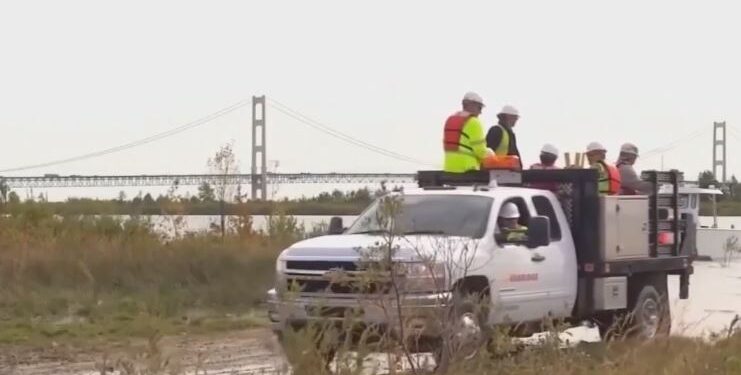LANSING, Mich. (WZMQ) – Progress is being made towards building a tunnel for the pipeline in the Straits of Mackinac. The Michigan Public Service Commission (MPSC) approved the site permit to relocate the Line 5 pipeline under the Straits of Mackinac.
The decision by the MPSC to approve Enbridge Energy’s permits for the Line 5 tunnel project has a contingency that Enbridge must also be granted the necessary government approvals and permits from the US Army Corps of Engineers (USACE) to move forward.
Dan Scripps, Chair of the MPSC said that so long as Line 5 continues to move crude oil and natural gas liquids through the dual pipelines lying on the bottom lands of the straits, it should be done safely.
“Over the course of today, approximately 540,000 barrels or 22.8 million gallons of crude oil and NGLs will flow through those lines,” Scripps said. “We find that Enbridge’s proposal to relocate the straight signal segment within a concrete line tunnel housed at the bedrock deep below the lake bed represents the best option to mitigate the dangers that current pipelines represent.”
The USACE is still conducting its environmental impact study to assess the tunnel’s safety and construction plans, but through the studies conducted by Michigan’s Mackinaw Straits Corridor Authority MPSC engineers determined that there is a public need for line 5 products and the replacement project to protect the resources of the Great Lakes.
The Authority also found that the route, location, and design of the line 5 replacement segment is reasonable and is a significant improvement over the current dual pipeline configuration and meets or exceeds current safety and engineering standards.
The project would replace the two, twenty-inch diameter pipes with one, thirty-inch diameter pipe and relocate it to a concrete-lined tunnel underground, beneath the Straits of Mackinac. The MPSC says that 14 intervening parties were involved in evaluating the project and that because the Michigan Environmental Protection Agency requires any projects that would cause potential impairments to the environment to explore alternatives, they evaluated other tunnel designs and alternative options and found the current project is the most effective with the least impact.
The MPSC case coordinator, Travis Warner, says that the commission carefully considered public comment while finishing the necessary analysis of the plans and project site.
“Throughout the case, the Commission and staff took steps to allow ease of access to information in the case for members of the public. The Commission received more than 23,000 comments and the record consists of more than 2500 pages.” Warner said. “The order finds that none of the alternatives evaluated are feasible and prudent alternatives to the proposed project, and many would have a greater environmental impact than the proposed project.”
Despite the determination of public need, advocates like Jade Prange, a public administration student at MSU, are expressing their disappointment in the MPSC’s decision.
“The climate is changing. we need to switch to sustainable energy quickly and our Great Lakes are the most important natural resource that we, as Michiganders and Americans, must protect.” Orange said. “This pipeline needs to be shut down, and this tunnel should never be built.”
Scripps said the MPSC is keeping in mind Michigan’s accelerating shift towards sustainable energy, but says the Commission aims to ensure current infrastructure is safe in the meantime.
“This energy transition won’t happen overnight,” Scripps said. “In the meantime, we have a responsibility to approve the infrastructure needed to meet our energy needs and to take steps necessary to get the current pipelines off the bottom lands.”
The USACE timeline continues to project a final decision on federal permissions in 2026, putting the project six years behind its original schedule, while still facing major opposition from state, environmental, and tribal leaders.

















